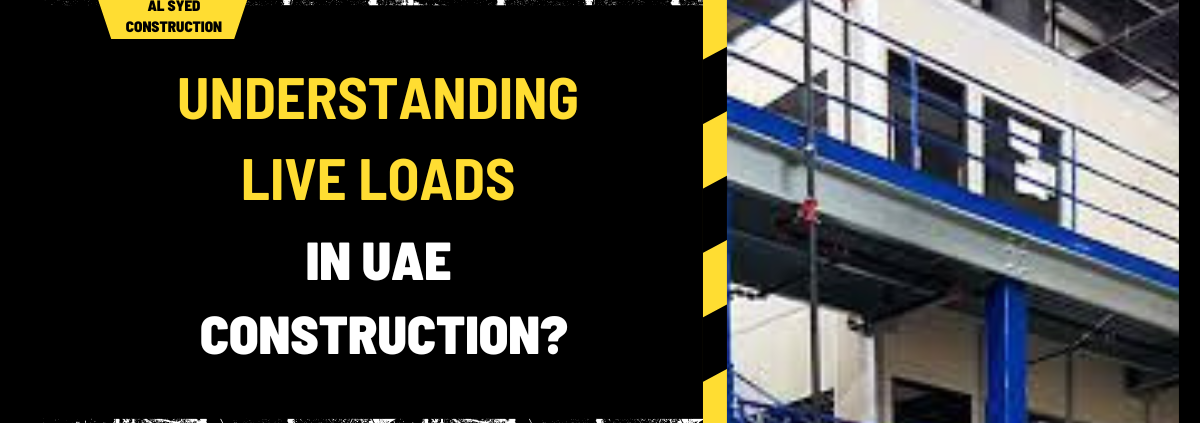Understanding Live Loads in UAE Construction
In construction, comprehending various load types is essential for ensuring structural integrity and safety. One critical aspect is understanding live loads. This article delves deeply into what live loads are, their importance, and how they impact construction design and engineering.
1. What Is a Live Load?
Definition of Live Load
A live load refers to the temporary, dynamic loads applied to a structure, which vary over time. Unlike dead loads, which are static and permanent, live loads are transient and subject to change based on usage.
- Dynamic Nature: Live loads include the weight of people, furniture, vehicles, and movable equipment.
- Variability: These loads fluctuate depending on how a space is used, making them critical in designing versatile and safe structures.
Examples of Live Loads
Live loads can be categorized into several types:
- Occupancy Loads: The weight of occupants in a building, such as people in an office or residents in a residential building.
- Furniture Loads: The weight of movable furniture and fixtures.
- Vehicle Loads: Loads from vehicles in parking structures or bridges.
- Snow Loads: Snow accumulation on roofs and other horizontal surfaces, considered a live load due to its variability.
2. Importance of Live Loads in Structural Design
Design Considerations
In structural design, considering live loads is crucial to ensure safety and durability:
- Structural Capacity: Engineers must ensure that the structure can support the maximum anticipated live loads without excessive deformation or failure.
- Flexibility: Buildings and bridges must be designed to accommodate varying live loads, ensuring functionality and safety under different conditions.
Building Codes and Standards
Building codes provide guidelines for calculating and applying live loads:
- International Building Code (IBC): Specifies minimum live load requirements based on building use and occupancy.
- American Society of Civil Engineers (ASCE) 7: Provides detailed load requirements and calculation methods for various types of structures.
3. Calculating Live Loads
Load Calculations
Calculating live loads involves several steps:
- Determining Load Type: Identify the type of live load relevant to the structure (e.g., occupancy, furniture).
- Load Magnitude: Use building codes and standards to determine the magnitude of the load. For instance, office buildings have different live load requirements compared to residential buildings.
- Load Distribution: Calculate how the load is distributed across structural elements, such as beams and columns.
Load Factors and Safety
To ensure safety, engineers apply load factors to account for uncertainties:
- Load Factor: A multiplier applied to the live load to account for potential variations and ensure the structure can handle unexpected loads.
- Safety Margins: Incorporating safety margins helps in accommodating unforeseen conditions and ensuring structural stability.
4. Impact of Live Loads on Different Types of Structures
Residential Buildings
In residential buildings, live loads are typically lighter compared to commercial buildings:
- Occupancy Load: Calculated based on the number of residents and their activities.
- Furniture and Appliances: Considered in load calculations to ensure floors and beams can support these loads.
Commercial Buildings
Commercial buildings experience higher live loads due to increased occupancy and movable equipment:
- Office Spaces: Live loads include office furniture, equipment, and the number of employees.
- Retail Spaces: Loads from shelves, merchandise, and customer traffic are factored into the design.
Bridges and Infrastructure
For bridges and other infrastructure, live loads are critical for ensuring safety and performance:
- Vehicle Loads: Calculated based on the types of vehicles expected to use the bridge.
- Dynamic Effects: Consideration of dynamic effects, such as traffic movements and vibrations, is essential for bridge design.
5. Live Load Considerations in Special Applications
Roof Design
In roof design, live loads include snow and maintenance workers:
- Snow Loads: Calculated based on geographic location and expected snowfall.
- Maintenance Loads: Consideration for workers and equipment during maintenance activities.
Floor Design
For floor design, live loads are crucial for ensuring durability:
- Load Bearing Capacity: Floors must support furniture, occupants, and any transient loads without excessive deflection.
- Code Requirements: Adherence to building codes ensures that floors meet safety and performance standards.
6. Challenges in Managing Live Loads
Variability and Uncertainty
Live loads can be unpredictable, posing challenges:
- Load Variation: The variability in live loads requires flexible design approaches.
- Uncertainty: Uncertainty in load magnitudes necessitates conservative design practices and safety margins.
Design Solutions
To address these challenges, engineers use several strategies:
- Overdesign: Designing structures to handle loads well beyond the expected maximum to account for variability.
- Continuous Monitoring: Implementing monitoring systems to assess live loads and structural performance over time.
7. Future Trends in Live Load Management
Advanced Modeling and Simulation
Emerging technologies are enhancing live load management:
- Building Information Modeling (BIM): BIM systems allow for detailed modeling of live loads and their effects on structures.
- Smart Sensors: Integration of smart sensors can provide real-time data on live loads, improving monitoring and maintenance.
Sustainability Considerations
Future trends also include a focus on sustainability:
- Efficient Design: Designing structures to efficiently handle live loads while minimizing material use and environmental impact.
- Adaptive Use: Creating adaptable spaces that can accommodate varying live loads with minimal modifications.
8. Conclusion
Understanding live loads is essential for the design and safety of various structures. By accurately calculating and managing these loads, engineers ensure that buildings, bridges, and other infrastructures can safely support their intended use. Advances in technology and ongoing research continue to improve our ability to predict and manage live loads effectively.




